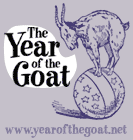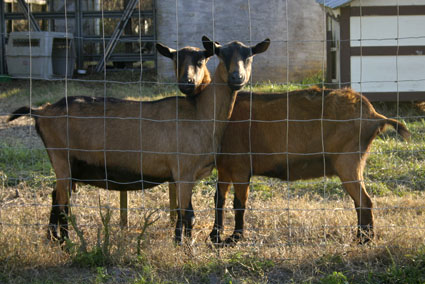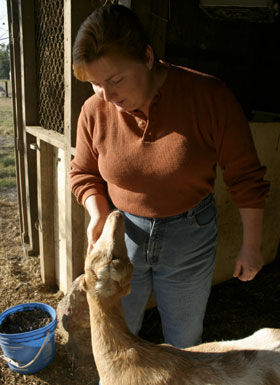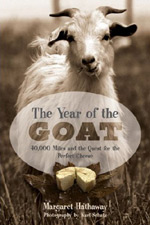In fact, we met Elizabeth in the Spotlight Sale Tent at the ADGA convention, where she was spending her last few days with an Oberhasli doe, Jolie, who had been chosen for the sale. Jolie was the first goat from Florida to be featured in a Spotlight Sale, and that honor is just one among many that the Devonshire herd have achieved. An active member in the Florida Dairy Goat Association, Elizabeth shows her goats frequently, and in the past has worked with 4-H, teaching children about goat husbandry and inspiring one young woman so much that she and her goats now board with the Kennelley family.
Elizabeth is a well informed and incredibly active goat farmer, which is why it surprised us to learn that she keeps CAE-positive goats in her herd. Caprine Arthritis Encephalitis, commonly called CAE, is a retrovirus that is spread through white blood cells and, at least for now, is incurable. Considered the HIV of the goat world, CAE causes chronic progressive arthritis, chronic pneumonia, hard udders, and, finally, ascending paralysis. Only 10-20 percent of CAE-positive animals show signs of the disease, which is why rigorous testing is recommended to identify positive animals. Washington State University has a widely respected system for testing (the chemically measured cELISA blood antibody test), and most blood samples around the country are sent to the their lab. It's generally acknowledged that the only way to truly manage CAE is to keep positive animals out of one's herd, or, if the animals aren't showing symptoms and the farmer doesn't want to cull, to segregate and stop breeding them.
Elizabeth follows a comprehensive testing program, sends her blood samples to Washington State, and segregates those goats who test positive, separating their pastures from the rest of the herd to prevent contact between positive and negative animals. But unless the goats begin to show symptoms of CAE — swollen, calcified knees, for instance, or hard udders — she doesn't cull them, and if their genetics are good, she continues to breed them through artificial insemination.
Unless there's a breech of the placenta, or the baby receives unpasteurized colostrum (the antibody-rich secretion that precedes milk during lactation) straight from its mother, most kids born of CAE-positive does test negative. As a scientist, Elizabeth judged this risk and decided that the genetic benefits outweigh the chance of CAE infection. Having worked for a decade on the composition of her herd, it is important to her to be able to pass along and continue working on the traits that she's been refining. She even continues to show CAE-positive animals; she just makes sure to be upfront about the animal's status, to keep it segregated from the other pens, and if the judge is touching the animals, to provide cleansing wipes. Several of her best animals, she says, have continued placing even after they've tested positive.
When Elizabeth began working with goats in earnest, about ten years ago, a veteran of the goat world told her that it would take about a decade for her herd to reach the level of excellence that she was working toward. In exactly that amount of time, the Devonshire herd has achieved the goals — in the show ring and on the farm — that Elizabeth set for them. Though some of her animals have ultimately tested positive for CAE, Elizabeth has chosen not to cull them in order to continue the progress that she's made on the genes of the entire herd. The management method she's adopted is much more labor-intensive than it would be to simply clear disease from the herd, but it's allowed her to continue the genetic lines on which she's worked so hard. —MMH



